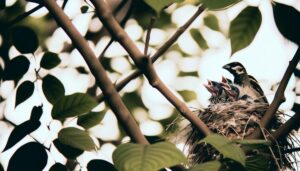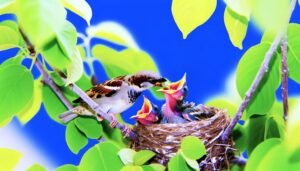How You Can Tell How Old a Baby Sparrow Is
To tell how old a baby sparrow is, observe its feather and beak development. Newly hatched sparrows have closed eyes and minimal down.
Pin feathers appear around day 5. By days 10-12, contour feathers unfurl into juvenile plumage.
Notice changes in the beak: it turns yellowish and hardens by day 7, becomes more rigid by day 14. Behavioral milestones are essential—begging calls, wing-flapping, and coordinated movements emerge progressively.
Fledglings display short hops and brief flights. Juveniles have streaked feathers and rely less on parents.
By tracking these details, you can pinpoint a baby sparrow's age accurately. For further nuances, continue below.
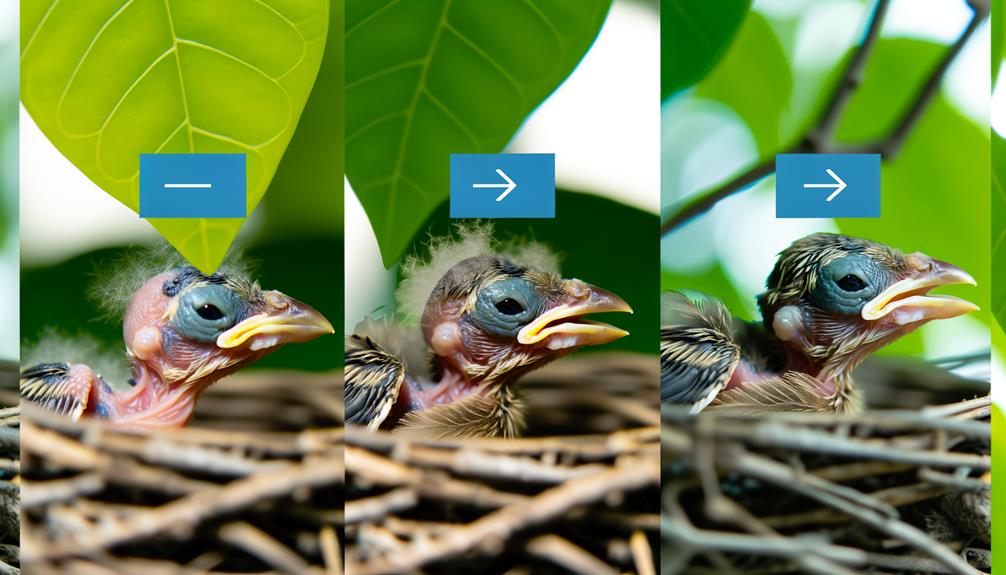
Key Takeaways
- Closed eyes and minimal downy feathers indicate a newborn sparrow.
- Pin feathers emerge around day 5 and unfurl into juvenile plumage by three weeks.
- Eye color shifts from closed to open with dark irises within the first week.
- Beak size grows, hardens, and turns yellowish by day 7, becoming more defined by day 14.
- Begging calls and increased vocalizations are signs of early developmental stages.
Hatching and Nestling Stages

In the hatching and nestling stages, you can observe that newborn sparrows (Passeridae) typically exhibit closed eyes, minimal downy feathers, and a reliance on parental feeding. Initially, their eyes remain closed for approximately four to five days post-hatching. The absence of feathers, except for sparse, wispy down, is notable.
During this critical period, nestlings depend entirely on their parents for nutrition, receiving regurgitated food. You'll notice that their growth rate is rapid, with significant changes occurring daily. Monitoring their feeding behavior and physical development helps determine their age accurately.
As they approach the end of the nestling phase, they begin to exhibit more active behaviors and vocalizations, indicating their gradual shift towards fledging.
Identifying Pin Feathers
You'll notice pin feathers, or developing feathers encased in keratin sheaths, emerging around day five. Evaluating their appearance helps determine the specific feather growth stages, essential for age estimation.
Understanding the molting process provides further insights into the bird's developmental timeline.
Pin Feather Appearance
During the early stages of a baby sparrow's development, pin feathers, also known as blood feathers, emerge as small, tubular structures encased in a keratin sheath.
You'll observe these pin feathers primarily on the wings, back, and tail regions. These feathers contain a blood supply that nourishes the growing feather, giving them a dark, almost bluish appearance.
Handle the nestling gently to avoid damaging these delicate structures. By closely examining the pin feathers, you can estimate the sparrow's age.
Typically, pin feathers start appearing around 7-10 days old. Detailed observation of their length and density will provide further insight into the bird's developmental stage.
Identifying and understanding these feathers is important for ensuring proper care and support.
Feather Growth Stages
To accurately determine the age of a baby sparrow, you should closely examine the stages of feather growth, particularly focusing on the development and characteristics of pin feathers. Pin feathers, or blood feathers, are essential indicators. Initially, they appear as small, tubular structures covered in a keratin sheath.
As they develop, these sheaths break open, revealing emerging feathers. In the earliest stages, pin feathers are bluish and semi-translucent due to the blood supply nourishing the growing feathers. As the sparrow matures, the pin feathers become more opaque and robust.
Observing these changes allows you to estimate the bird's age accurately, contributing to its care and rehabilitation. By understanding these stages, you'll provide better assistance to these vulnerable creatures.
Molting Process Insights
In the molting process, pin feathers emerge as vital indicators of a sparrow's developmental stage, providing essential information on its age and health.
You'll notice that pin feathers are encased in a keratin sheath, appearing as small, quill-like structures. These nascent feathers, also known as blood feathers, contain a rich blood supply necessary for growth.
By examining the length, number, and condition of pin feathers, you can accurately gauge a baby sparrow's age. Newly formed pin feathers are short and densely packed, signifying early stages of feather development.
As they mature, the keratin sheath flakes off, revealing fully developed feathers. Monitoring these changes allows you to assess not only the bird's age but also its overall well-being.
Feather Development Stages
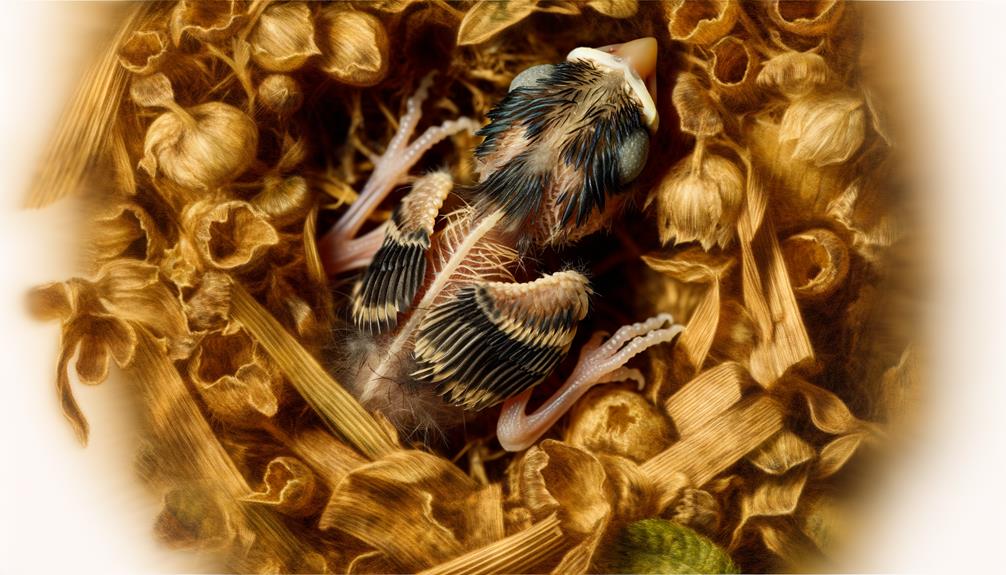
Observing the feather development stages in a baby sparrow provides significant insights into its age and growth progression. Initially, you'll notice the presence of down feathers, also known as natal down, which are sparse and provide minimal insulation.
By day five, pin feathers, or sheathed feathers, begin to emerge. These pin feathers are dark, tubular structures that eventually unfurl into juvenile plumage.
Around day 10 to 12, contour feathers, which are more developed and provide better coverage, start appearing. By three weeks, the sparrow will exhibit a full set of juvenile feathers, indicating it's ready for short flights.
Monitoring these stages meticulously allows you to estimate the bird's age accurately and ensure appropriate care for its developmental needs.
Eye and Beak Changes
You'll observe significant changes in a baby sparrow's eye color and beak size as it matures. Initially, the eyes are closed and gradually open, shifting from a dark color to a lighter hue.
Concurrently, the beak grows in size and changes in coloration, indicating different growth phases.
Eye Color Development
A baby sparrow's eye color shifts from a closed, opaque state to gradually opening with dark, nearly black eyes within the first few days. Initially, the eyelids remain sealed, providing a protective barrier.
By day four to five, you'll notice the eyes starting to open, revealing dark irises. This early stage is crucial for evaluating developmental health. The dark eye color persists but lightens slightly as melanin production stabilizes.
Observe the consistency of eye color since deviations might indicate health issues. By the end of the first week, the eyes are fully open. Monitoring these changes allows you to accurately gauge the baby sparrow's age and ensure its well-being, facilitating timely interventions if necessary.
Beak Size Growth
Noticing the beak size growth is crucial, as the beak starts as a small, soft structure and hardens while elongating noticeably within the first two weeks.
Early-stage nestlings exhibit beaks that are relatively brief and pliable. By observing the progressive elongation and hardening of the beak, you can pinpoint the bird's age more precisely.
Around day 7, the beak's tip begins to harden and turn yellowish. By day 14, the beak is more defined and rigid, indicating nearing fledging.
Monitoring these changes requires a keen eye for detail and a commitment to the sparrow's development. Therefore, correctly evaluating beak growth aids in providing appropriate care and fostering successful rehabilitation or release into the wild.
Behavioral Milestones
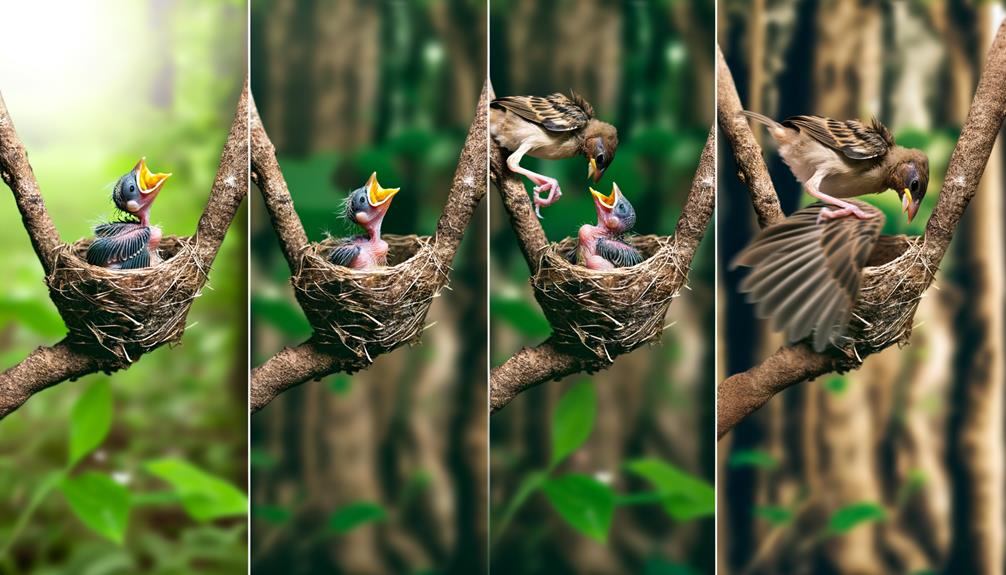
Observing a baby sparrow's behavior can provide valuable clues to its age, as specific milestones such as begging for food or attempting to fly occur at distinct developmental stages.
Initially, you'll notice altricial behaviors; hatchlings exhibit frequent begging calls and gape widely for food, a sign of their reliance on parental care. By day 5-9, they start to display more coordinated body movements.
Around day 10-14, fledglings may engage in wing-flapping exercises, indicating muscle development for flight. You'll also observe exploratory pecking behaviors and increased vocalization as they approach fledging age.
Identifying these behavioral milestones requires keen observation and a structured approach, essential for providing appropriate care and ensuring their successful progression from nestling to fledgling stages.
Growth of Flight Feathers
As you monitor these behavioral milestones, you'll also need to track the growth of flight feathers, which serve as a key indicator of a baby sparrow's developmental stage.
Initially, you'll observe the emergence of primary and secondary feathers, known as remiges, on the wings. These feathers start as pin feathers—short, quill-like structures encased in a keratin sheath.
As they mature, the sheaths break away, revealing the barbs and vane essential for flight. Examine the length and condition of these feathers; at around 10-14 days, they should be sufficiently developed to support fledging.
Pay close attention to symmetry and overall feather condition, as these factors are essential for proper aerodynamics and survival in the wild.
Fledgling Indicators
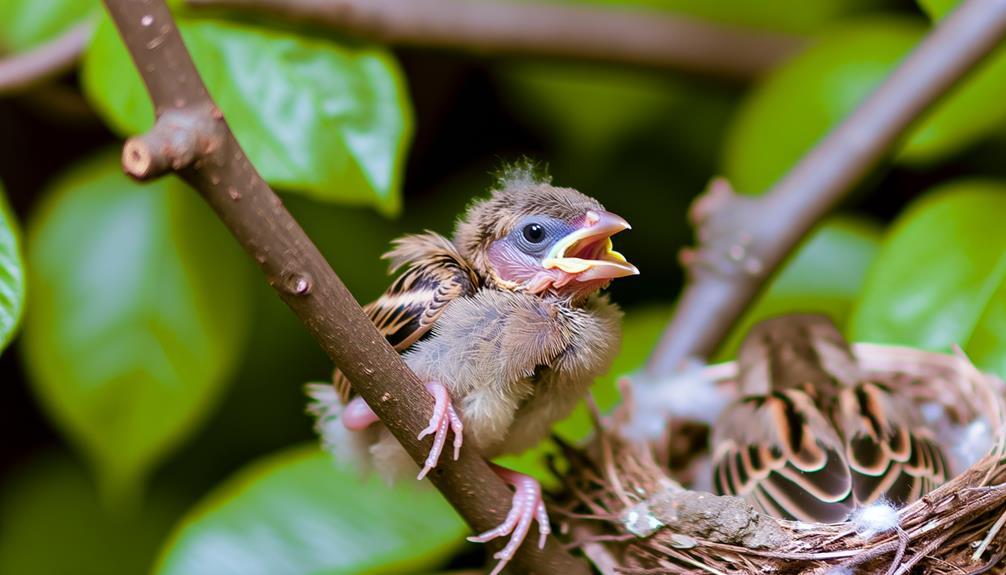
Fledgling indicators include the baby sparrow's ability to hop, flutter short distances, and exhibit increased vigilance and receptivity to environmental stimuli. By examining these behaviors, you can estimate the age of the fledgling sparrow with greater precision.
| Indicator | Description | Observation Frequency |
|---|---|---|
| Hopping | Short, controlled leaps | Frequently observed |
| Fluttering | Brief, low-altitude journeys | Occasionally observed |
| Vigilance | Increased eye movement and head orientation | Constantly observed |
| Receptiveness | Response to sounds and moving objects | Frequently observed |
These indicators signify the shift from nestling to fledgling stage, marked by developmental milestones that are crucial for survival. Observing these behaviors helps you understand the fledgling's readiness for independent life.
Juvenile Characteristics
Juvenile sparrows exhibit distinct plumage patterns, including streaked feathers on their chests and backs, which differentiate them from fledglings and adults. You'll notice these streaks are less pronounced and more uniform compared to the speckled plumage of fledglings. Juveniles also lack the fully developed, bold coloration of adult sparrows.
Observe their beak, which remains slightly yellow at the base, indicating incomplete maturity. Their behavior is also a clue; juveniles often display increased independence yet still rely on adults for occasional feeding. Additionally, their vocalizations are more complex than those of fledglings but not as refined as adult calls.
Conclusion
By observing a baby sparrow's physical and behavioral traits, you can accurately estimate its age. Fascinatingly, pin feathers typically emerge around day 4 or 5, offering a critical age marker.
Recall that the growth of flight feathers, eye development, and beak changes provide additional, precise age indicators. With detailed observations and understanding of these stages, you're equipped to determine a baby sparrow's age with scientific accuracy.
Did you know sparrow fledglings usually leave the nest at just about 14-17 days old?



